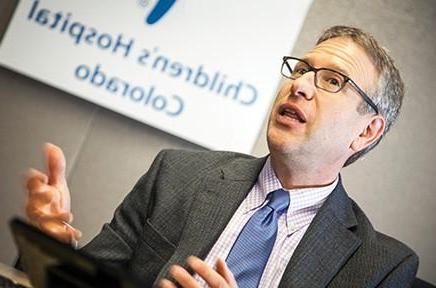编者按: 早在远程医疗最终广泛进入消费者市场之前, innovators in health delivery in Colorado were experimenting with ways to use technology to provide access to hard-to-reach places and hard-to-reach people. 道格拉斯·诺文斯,马里兰州, is associate professor of psychiatry in the Centers for American Indian and Alaska Native Health and the Division of Child and Adolescent Psychiatry at the University of Colorado School of Medicine, 也是科罗拉多州儿童医院的精神病学主任. 在每一个地方, Novins and colleagues for years have reached out through video connections to locations near and far in search of more humane and efficient care. We talked with Novins about how early telemental health efforts have evolved over the years.

你参与的第一个视频健康项目是什么?
We received funding at (the University of Colorado Anschutz Medical Campus) around the year 2000 from the U.S. 农业部, which had put out an ad for people to work on telemedicine and mental health in rural communities. 技术进步了,在他们的资助下,这似乎是可行的. 这让我们可以买到这些大的, 笨重的CRT视频会议装置, bundling six standard land lines and use them as a single pathway; with six lines you could get a decent – but not great – video connection. 我们在安舒茨校区的五个部落社区做了这个实验.
The services we started early on were a child mental health consultation to a hospital in South Dakota run by the Indian Health Service. They’d had 10 years of child psychiatrists working in the hospital as part of the federal pay-back-your-medical-school-loans program, 但在那之后,他们就找不到新人了. So they’d built up a clinic of all these kids and a good reputation at the reservation they served. 然后突然间它消失了. 他们有一个普通的精神病医生, 但他们不一定能适应特定的年龄群体或需求. 他们还有一位需要更多支持的执业护士. 所以我们开始了咨询服务. 许多家庭会陷入困境, 我们会在房间里和家人和医生一起进行临床治疗, 还有治疗计划——通常是一次性咨询. 这个项目我们做了7年. 这是一次双向对话.
另一个早期项目是阿拉斯加一家医院的老年会诊. 在那里,我们关注的是病情严重的老年人群, 而且当时没有很多本土的心理健康专家. They were consulting to internal medicine folks on people with complex neuropsychiatric cases, 这种情况持续了几年.
你还与美国政府开展了一些合作.S. 退伍军人事务部.
我们与退伍军人事务部的合作是最大的. 它真的成功了. 我们从南达科他州的一个保留区开始提供服务. Now the VA runs it and it has six reservations: in Oklahoma, Arizona, Wyoming, Montana and Idaho. 在那些保留地, 印第安人基本没有心理健康服务, 也没有退伍军人心理健康方面的专业知识. 所以我们围绕视频会议来做. 这里的精神科医生每周做一次门诊, 由退伍军人事务部雇员的部落代表在偏远地区提供支持. That tribal representative is key on the other end – they help the veterans get their proper benefits. 部落外展工作者是当地精神科医生的眼睛和耳朵. 这是一位在社区中广受尊敬、人脉广的老兵, 确保大家都过得很好, 让人们知道诊所, 鼓励他们寻求治疗. 如果他们失踪了,(部落外展工作者)就会出去找他们. 这是一个关键因素. 精神病医生正在做评估, 临床护理, 心理治疗和药物管理, 而且是在安舒茨的一个房间里.
你有没有尝试过药物滥用这一重要领域的视频健康?
这是一个相对较新的事物,大约始于2005年到2006年. 阿拉斯加有个药物滥用机构. 我们帮助那里的医生进行精神评估. And we help with medication management; we provide supervision and backup. 如果有资金的话,我们确实喜欢亲自拜访. 这里的每个精神病医生每年都要去两次. We get to see about two-thirds of our patients in person at some point in their care. But meeting people in person in addition to the video is particularly important to establishing and maintaining relations with the other providers and staff up there. We can provide stability – we’re now the longest-serving members of that residential treatment program on the clinical side. 即使在2500英里之外,我们也能提供这种连续性和制度历史. A lot of rural communities may get a provider that will move on in a couple of years. 当然,我们在城市接受训练,我们喜欢城市. 这就是我们想要的. The chances of luring one of us to a rural community for 10 years or more is pretty low.
How has any of this work or experimentation translated to different kinds of health care consumers in Colorado, 随着技术的进步和需求的变化?
几年前我成为儿童医院的精神科主任. 我们的进度比我希望的要慢一些,但还是有一些事情发生. So the first is an internal need: We now have a network of emergency and urgent care facilities across the Front Range. It’s a network of care; as we open those facilities, 人们带着孩子来这里是因为各种各样的问题, 包括有心理健康危机的孩子. The standard practice before was put that kid in an ambulance and transport to the Aurora hospital to see an emergency psych staffer. 它非常昂贵,效率低下,对家庭来说也很艰难. 在你第一次来的地方等着然后坐上交通工具,然后在奥罗拉等着, 评估可能需要6到8个小时. 那么你有50%的几率会回家,而这已经是12个小时之后了. Or we admit you and send you to the inpatient facility back to where you came from in Highlands Ranch. 所以在2015年初,我们开始通过远程医疗来治疗. 我们接到一个电话, 我们建立了视频会议, 通过视频看到孩子和家人,无论他们是在哪里接受治疗的, 找出他们该去哪里. 它使医疗更加高效, 事实上, 很多家庭都很喜欢, 这是医院系统中许多人担心的问题吗.
Another thing we are working on right now – how can we support rural primary care facilities with pediatric mental health? 我们在杜兰戈有一个儿科诊所的试点项目. 我们有一位精神科医生在那里为从业者提供咨询. 这是合同. Our child psychiatrist is both seeing the patient through video link and talking with the local provider.
家庭远程医疗服务还有其他前景看好的领域吗?
我们正在开发一些电话家庭服务. We have patients in highly specialized subsets like the eating disorder unit and autism spectrum disorders and intellectual disabilities with mental health crises. 那么当孩子们回家后,我们如何利用这些专业知识来支持他们呢? 我们能不能做远程家庭或者让初级诊所主持一个我们远程提供服务的诊所?
当你们在15年前开始这些努力的时候, 你认为视频健康会发展得更快吗?
从某种程度上说,我很惊讶人们的接受速度如此之慢. 对我们来说,它从一开始就运作得很好. The technology in 2000 was clunky, but the tech turns out to be the easy piece of it. More of it is the long distance – making that still work – and how you structure clinics. 我们能够很快地解决这些问题, from our perspective – create effective and efficient services just as if we were there. 有很多阻力. 很多人质疑它是否等同于面对面的护理,隐私,技术. 直到大约五年前,事情才真正朝着可以接受的方向发展. It’s still not moving as quickly as I think it could, at least in parts of the system. 卫生保健创新的传播, 这些东西要花很长时间——15到20年——才能出来. 如果我戴上我的研究帽,我会这么说.
总的来说,病人真的很喜欢它. 平均, they find it very convenient when you consider what they’d have to go through to see us face-to-face. 我们有病人从拉军政府来到丹佛接受退伍军人管理局的服务. 不用开那么长的车是一个很大的改变. 人们觉得他们可以和我们建立良好的关系,我们也有同样的感觉. 我认为病人比医生更能接受这一点. 阻力主要来自供应商和他们对该项目的满意. 在阿拉斯加, 大约每24个月一次, 病人真的很抗拒,很难适应视频设备. 但现在这是罕见的例外.
视频健康还有其他令人惊讶的挑战吗?
一些服务仍然存在保险报销问题. 还有责任问题. 如果你和一个孩子一起工作,发生了紧急情况怎么办, and they’re in a home 150 miles away and you don’t have the backup you would if you were working with a pediatric practice? 你如何为这些突发事件做计划?
Have you encountered any cultural differences with the communities you serve that have implications for long-distance telemedicine or telepsychiatry?
远程医疗存在固有的文化挑战. The biggest is that you’ve got urban providers giving service to a rural community they’ve never visited and may not understand very well. So they need to have a sense of the community and what’s important there: the local calendar of events, 接下来会发生什么?, 浏览本地新闻网站, 询问社区中正在发生的事情, 了解学校环境在一个小社区中的重要性,诸如此类的事情.
你还想分享其他的经验吗?
Here’s one thing people don’t realize about telemedicine: Unless we change the way we practice, 这是一个零和游戏. I spent two hours yesterday on my clinic to Alaska – that’s two hours less of me practicing in Denver. 这就是再分配,对农村地区有好处. But if in child psychiatry we don’t have enough people to take care of patients that are here in Denver, 那么从整体的角度来看,你并没有真正改变什么. 所以问题是我们如何利用远程医疗来扩大医疗服务提供者的数量? One answer is that I can use it to help other people who are providers, even if I'm not there.
本文最初发表于2016年秋季期的《365bet》杂志.
